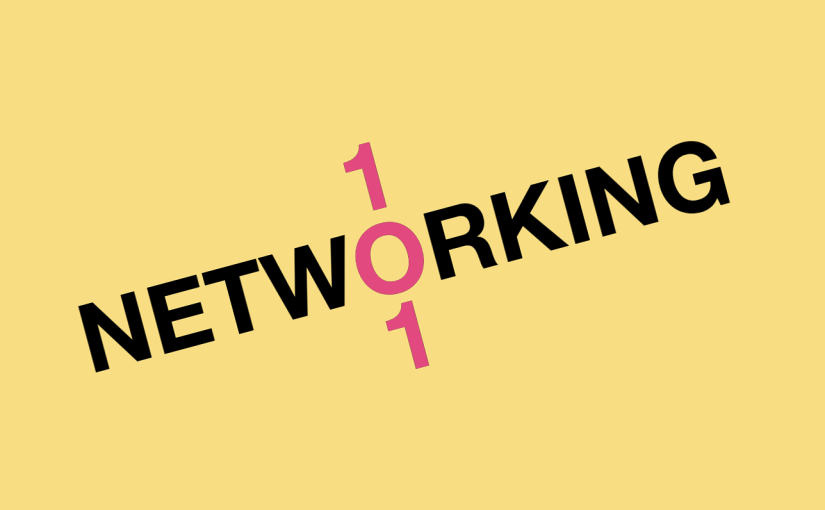For many businesses, networking is hands down the most cost-effective activity for generating customers. For these businesses, networking will be the highest return on investment, and generate the highest quality leads and referrals.
The catch is it takes time to develop a solid network. But if you plan on being in business for a while, start networking ASAP!
In this guide, we’re going to write our hearts out on how to do this effectively and try to cover every possible detail we can think of. Please save this guide and share it with your friends and of course, your networking buddies!
Why You Should Get Excited About Networking: Referral Sources
When most small businesses think about how to grow, they think: leads.
Lead generation usually sucks.
Most businesses will try to buy leads and the lead quality is terrible or the leads have been hit up by other businesses already.
One thing we have learned is most small businesses haven’t heard of the words: referral sources.
Referral sources are what you should be going after.
Referral sources are people or businesses that naturally send prospects and customers to you because they know you and trust you to take care of the people they refer to you.
Here’s an example:
Bob knows that Jim is an attorney. Bob needs a contract written. However, Jim is a criminal defense lawyer and not a business lawyer. Drafting up contracts isn’t Jim’s specialty.
So Jim refers Bob to Jane who happens to be an amazing business lawyer.
Jim is Jane’s referral source.
Jane doesn’t pay Jim for the referral.
Instead, Jane refers Jim people when Jane is asked if she can help with DUIs, or when their sister’s husband’s cousin gets in trouble with the law.
Criminal defense isn’t Jane’s cup of tea. That’s what Jim does.
Jim could pay $100,000 a year on advertising to get clients. Or he can develop referral partners which don’t cost money, just time. Or he can do a bit of both.
Why should you get excited about referral sources?
Well, the obvious part is that referrals are free. They are also better than leads, because the prospects that are sent your way are qualified, exclusive, and warmed up. It’s much easier to sell a referral than a lead.
But what should really get you excited is that you can have as many referral sources as you want if you’re willing to take the time to establish them. That multiplying effect is quite a growth and profit driver.
What Networking Isn’t
When you engage in networking, the point is not to drum up sales or leads. It’s possible you’ll get a customer right off the bat sometimes, you just don’t want to go in with that mindset.
It’s also not a massive business card collecting event so you can fill up your CRM when you get back.
The point of networking is to build your referral source network.
Let’s get into how to do it well..
The Business Networking Recipe
1. Identify Where To Network
- Ask around
- Chamber of commerce events
- Linkedin & Alignable
- Meetup.com
- Paid business networking groups
- Smile
- Engage in natural, casual conversation
- Try not to talk too much, let the other person get words in
- If you’re excited to meet someone, express it!
- Avoid talking about politics and religion
- Sports, family, hobbies, travel, and food are fine to talk about
- If there’s alcohol and you drink, then be responsible
- Name
- Can I refer to this person?
- Does this person have referrals for me?
- Vibe
- Who would you like an introduction to?
- Describe your ideal customer.
- How do you obtain most of your customers?
- Is there anything people say that would be a signal that they’d need your help?
Asking People
Ask other business owners if they do any networking around your local area. Start compiling a list of events and groups to visit. Now, some business owners may sound grumpy, say something negative, or say things “It didn’t really work for me”. Ignore the sentiment. Most people aren’t great at networking so it’s most likely their own lack of networking skills that gave them a less-than-positive experience.
Chamber of Commerce
Almost every city will have a chamber of commerce. You can just Google: city name + chamber of commerce and you’ll find the local chamber’s website. On the website, you’ll probably see a calendar of events or you can contact them from the contact page. Most of the time you can just show up at an upcoming chamber event and start networking with the people who are there.
Some chambers are more active than others. Feel free to try neighboring cities and see which ones you like best.
LinkedIn & Alignable
LinkedIn is pretty amazing. You can almost do all your networking from the platform. You can search for the exact people you want to meet and see if they want to meet for coffee or do a virtual chat. However, this is probably not the most effective way to network because you have to engage people one at a time. It turns out this is a really slow way to build a network.
The good thing about LinkedIn is you can ask your followers where they network or search for networking events using their search bar. Depending on how many followers you have and the industry you’re in you may get a flood of responses and results. So give it a shot!
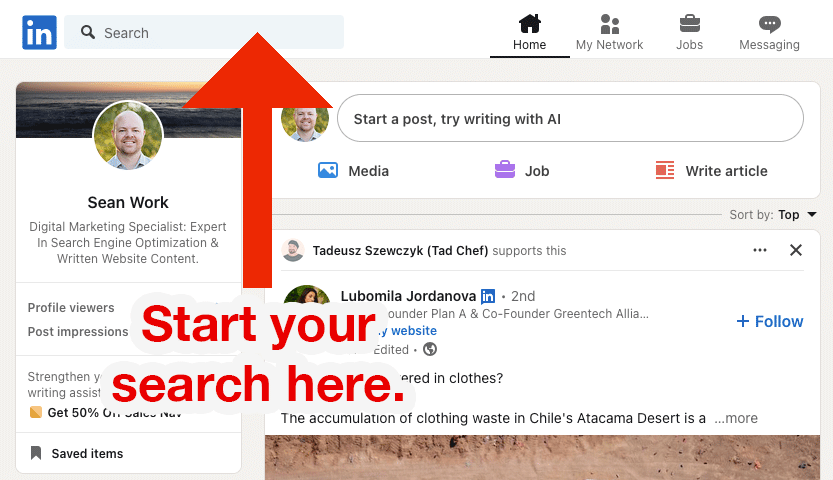
LinkedIn will spit out a mix of results from profiles, pages and groups. Feel free to sift through all of it. You might want to start your focus on Groups first. Be sure to make your search geographically specific, otherwise you’ll only find online networking groups.
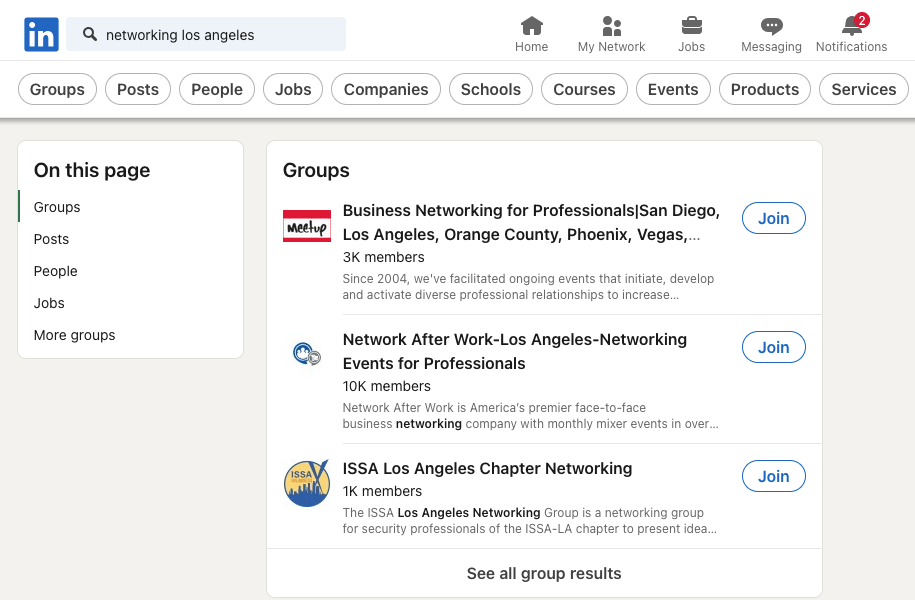
Alignable is similar to LinkedIn, but it might be even better for small businesses. LinkedIn is full of a lot of 9-to-5ers who don’t need to do business networking. Alignable is really geared towards small businesses. The only issue is the site is newer and has a smaller user base at the moment.
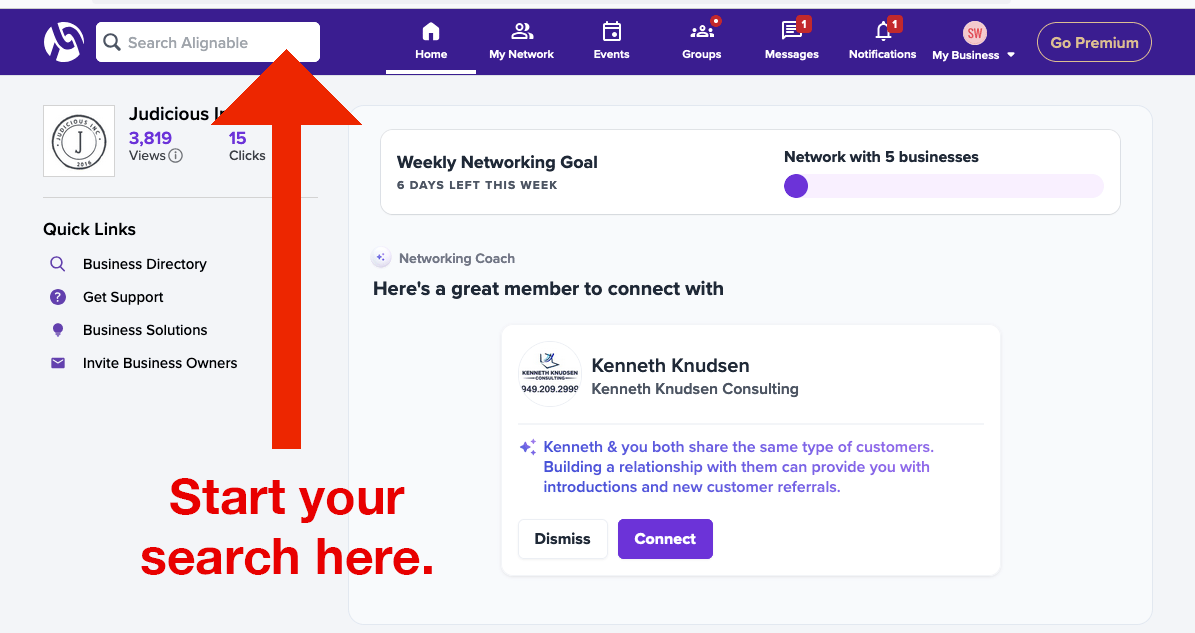
Be sure to select “Group” to see a list of networking groups on Alignable.
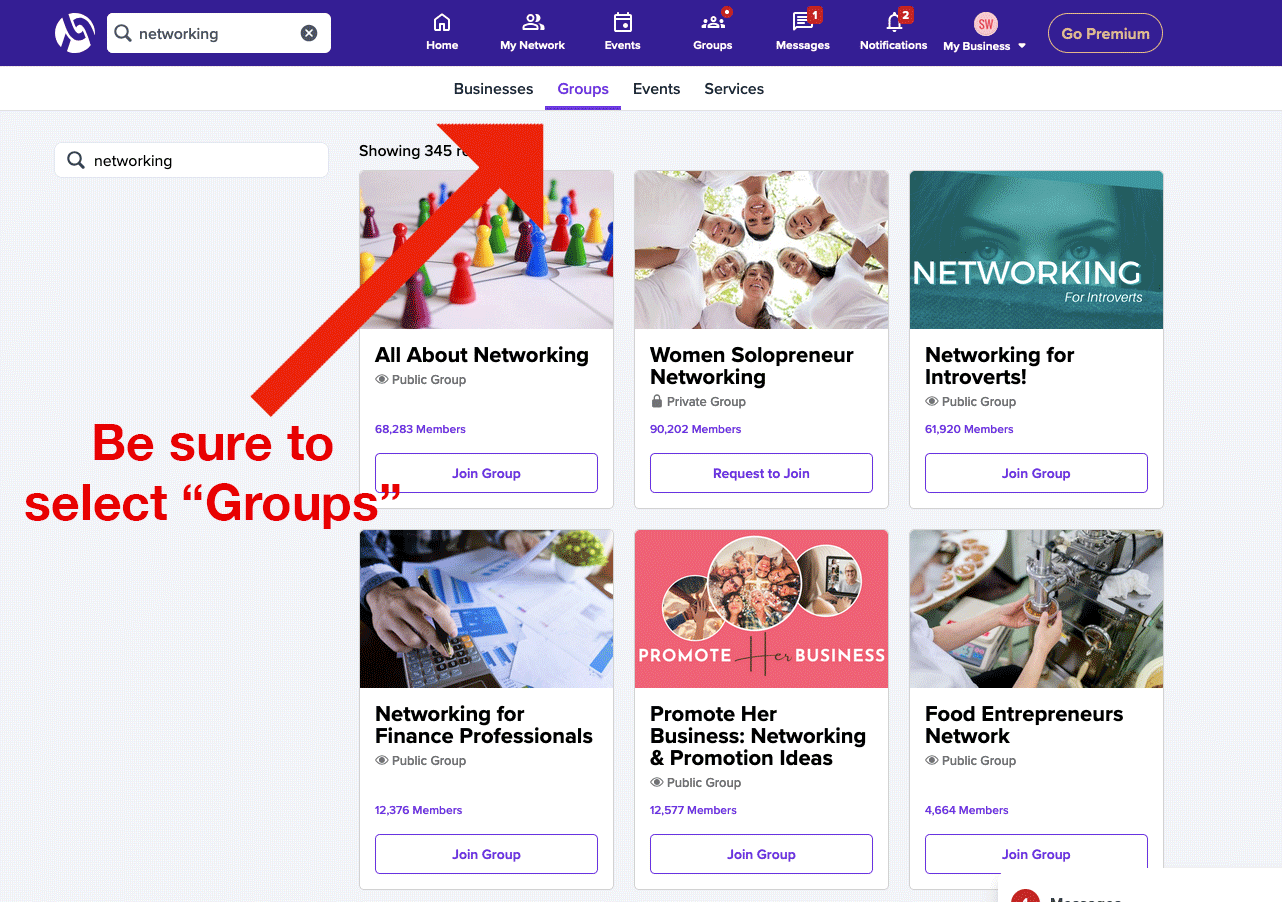
Meetup.com
This site doesn’t seem to get as much buzz these days as it did ten years ago. But the site was designed for exactly what we are talking about here. Simply go to Meetup.com and search using queries like “networking”, “network”, “business meetup”, and “start up” in your geographical area.
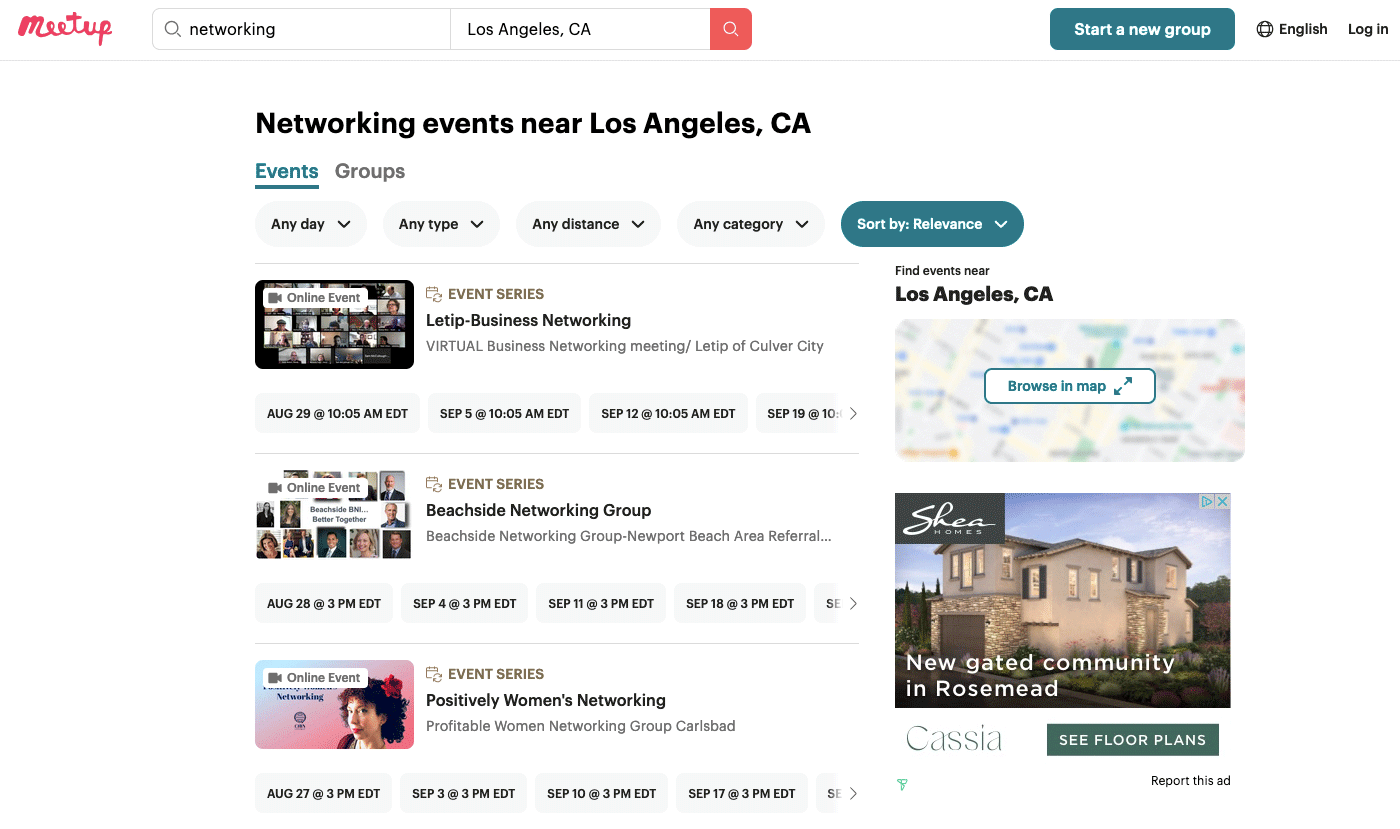
Paid Networking Groups
There are numerous networking groups that require paid membership. They work very well and you get the added benefit of developing deeper relationships since you meet with the same group of people regularly. You can usually visit these networking groups for free the first time. Some paid business networking groups include Letip, Provisors and RBN.
2. Schedule To Go To Some Events In Your Calendar
Pick an event (or events) to attend every week or two. You can go as often as you like but you do need to be mindful of your time and energy. Sometimes, if you do too much networking, you won’t follow through on the important steps we’ll talk about later.
Be sure to block out some time on your calendar and set reminders. Also, schedule time for yourself to travel back and forth from the event. If you don’t do this, and you use booking apps, people can schedule time on your calendar when you’re not back at your desk.
For some of you, you might not think this is a big deal, but to the other person, having a call or meeting with someone who is actively driving on the call can seem unprofessional (it’s easy to tell that the person’s focus isn’t 100% on the meeting when they’re driving).
3. IMPORTANT: Before You Go, Get In Your Networking Mindset

Remember, don’t go to these events with the goal of getting new customers, sales or leads. You’re going to build your referral network.
Building your referral network is a more effective use of your time in the long run than trying to get a couple of leads.
You’re looking to meet people who can be a great referral source for you or your business AND that you can be a good referral source for them. That’s the golden ticket you’re looking for.
4. Go To The Events, Shake Hands, Exchange Business Cards and Learn What People Do
When you go to these networking events, be sure to bring your business cards. For some of you, it may sound old-school, but it doesn’t hurt and people will ask for them. So come prepared. You can still exchange info with your phones or digitally.
Engage in casual conversation with people at the event. You don’t have to be all business and boring. Here are some tips:
A word on talking too much and not talking too much
The goal is really to have a balanced, casual conversation. You don’t want to dominate the conversation and not let the other person get a word in. On the other hand, you don’t want to be silent and seem uninterested. Not all conversations will go smoothly, just be mindful of keeping it balanced. Remember, both you and the other person are humans and you are not required to be perfect.
How to end a conversation and move on
This might be the hardest thing for most people to do. It can be really awkward to end a conversation with the goal of meeting other people. You can politely say, “It was a pleasure chatting, I’m going to mingle with a couple more people before I get out of here”. Or something to that effect. The purpose of the event is to talk to more than one person, so don’t be afraid to end a conversation.
5. Determine who you want to be your referral partners
After the event, we recommend making a spreadsheet and creating columns for:
Go through your business cards and/or your memory and fill out your spreadsheet. If you find someone that you can refer to, they can refer to you AND you like them, then you have found a potential referral partner.
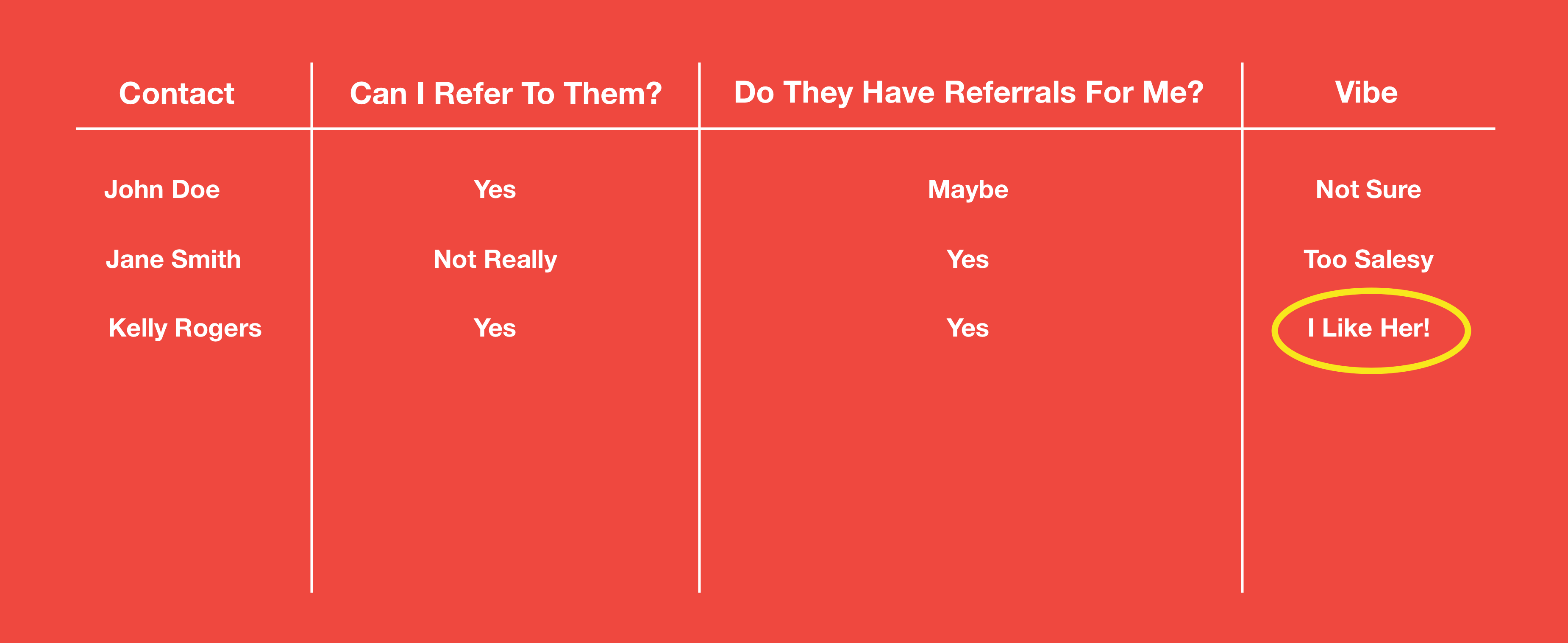
6. Schedule a meeting with your potential referral partners
You can invite them for coffee or schedule a virtual session on Zoom or Google Meet (or your preferred conferencing platform). During this meeting learn about the other person’s business. Ask the following questions:
Take good notes and just let them talk. The more you learn about their business, the more you’ll be able to help refer them to prospects and future customers.
7. Keep Up Your Relationships
This is the most important step.
It’s really easy to meet people one time and then never talk to them again. This happens a lot in the networking world.
However, the best networkers keep in touch with their referral partners. They nurture their relationships. And these people are usually successful in business.
People that do a lot of networking at first, but never keep up relationships are the ones that burn out, quit, and spin their wheels.
Networking isn’t rocket science. There’s nothing hard about it. It just takes time. So many people are impatient when it comes to business development and that’s the main detriment in the long run.
We’ve condensed the business networking recipe above in this video. Feel free to take a look!
Who should do the networking?
This is a great question.
Some people are naturally better networkers than others. And if your business has more than one employee, one of these employees will be the best at networking. Let’s go over a few scenarios and discuss who should do the networking in each case.
The business has a salesperson or team
Salespeople are usually a good fit for networking since they’re usually comfortable around people. The only issue is if they are going to network just to find customers and leads. Remember, the point of networking is to build a network. Therefore, your sales team should get some basic networking training before you let them loose.
The business is small, but has a receptionist or assistant
If the business has a small headcount but does have a receptionist or assistant to the owner, then that person can be a good choice for networking. We recommend they get some coaching first, but this can be a great solution when you need to free up time for the business owner. However, it might be best that the owner does the networking and the assistant or receptionist does other tasks.
The business has an owner who’s a control freak and is terrible in front of people
In this case, the business owner may think they should be the one doing the networking. And it’s clear to the rest of the team that the business owner SHOULD NOT be networking. This doesn’t mean the business owner is bad at business or shouldn’t be in business. It’s just that they need to focus on their strengths in the business. In this case, the business owner needs a coach. Let us know if you need one! We know a lot of business coaches because we’ve networked with several :).

